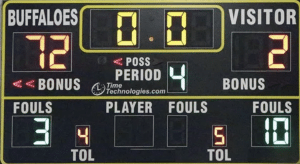
This article is republished with permission. The original article was written by Don Siko and appears at Reasonable Defensive Expectations – because there are no shutouts in basketball.
 Finishing up some current thinking on charting individual player defensive accountability, we’d like to share one more thought on how coaches can use postgame defensive charting to zero in fixable issues:
Finishing up some current thinking on charting individual player defensive accountability, we’d like to share one more thought on how coaches can use postgame defensive charting to zero in fixable issues:
In the sample defensive accountability spreadsheet we’ve used twice before, the team in question gave up 68 points and we assigned accountability to each point two different ways-by player and by the type of score (missed containments, closeouts, blockouts etc.).
- Every coach out there implicitly understands that of the 68 points scored by the opponent, only a certain number of points were especially avoidable. While coaches would like to think that all or most scores against us can be prevented, history tells us otherwise.
- Most good coaches practice honesty with their players when it comes to this issue. When coaches preach a defensive philosophy or technique and the player executes it perfectly and a score still is the result, most coaches don’t then blame that player for the result. There are many examples but a couple illustrations follow:
- A perfect blockout and the ball bounces long to the opponent.
- A perfect closeout and the opponent buries the trey in spite of little or no space.
- So, let’s agree that only a certain number of points given up in a game are “truly” accountable.
- If that it is the case, there is obviously a baseline number, or if you will, a benchmark by which the 68 points can be evaluated. For sake of argument. Let’s choose the Virginia Cavaliers as the benchmark team. If we agreed that if Virginia played in that same game, they would likely have given up roughly 52.7 points (their current nation-leading points against total). Granted, Virginia’s slow pace of play contributes to this low total but we also shouldn’t forget that Virginia is also 3rd in the nation in defensive FG%, 5th in defensive 3pt FG%, 6th in TO margin and 5th in fewest fouls. As long as I’m talking Virginia, I also have to ask why the Cavaliers’ defense, aside from pace, isn’t more widely and routinely copied by others. Ironically, I’m quite sure that as the Virginia staff self-evaluates, among the 52.7 ppg they surrender are points that they believe are avoidable according to THEIR baseline or benchmark standards.
- So, the purpose of this exercise is that now that we have a baseline of 53 points (maybe 58 adjusted to pace), we’re really focusing in on the 10-15 “worst” points we surrendered, no matter which player was accountable or which type of score we gave up. Sometimes these points given up are one-offs; sometimes not. But, if we especially emphasize these 10-15 points to our players, it’s another way of zeroing in on a teaching tool and how we can get our players to adjust and improve defensively from game to game. “Shrinking” the defensive game results down into some sort of synopsis is good for players. What method one uses can vary from coach to coach.






